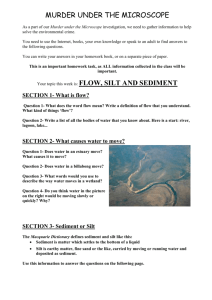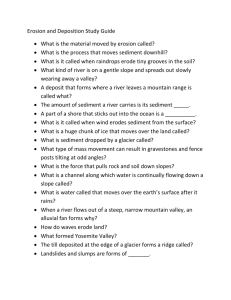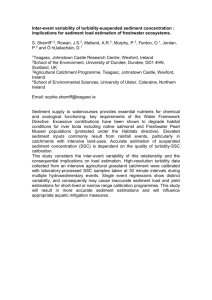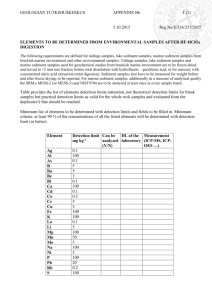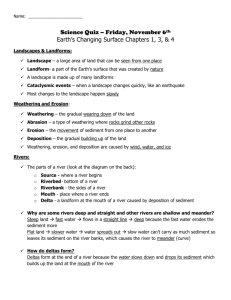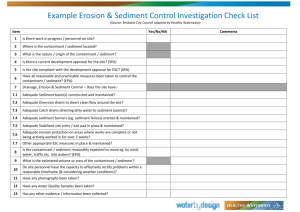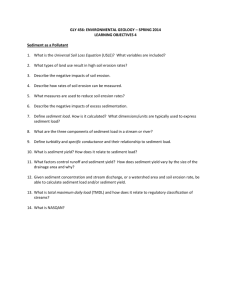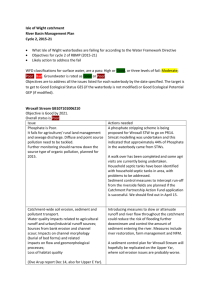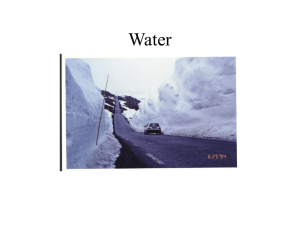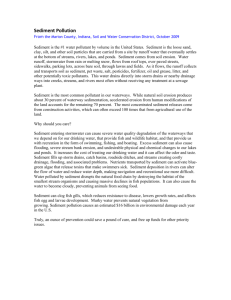Road Surface Erosion on the Jackson Demonstration State Forest
advertisement
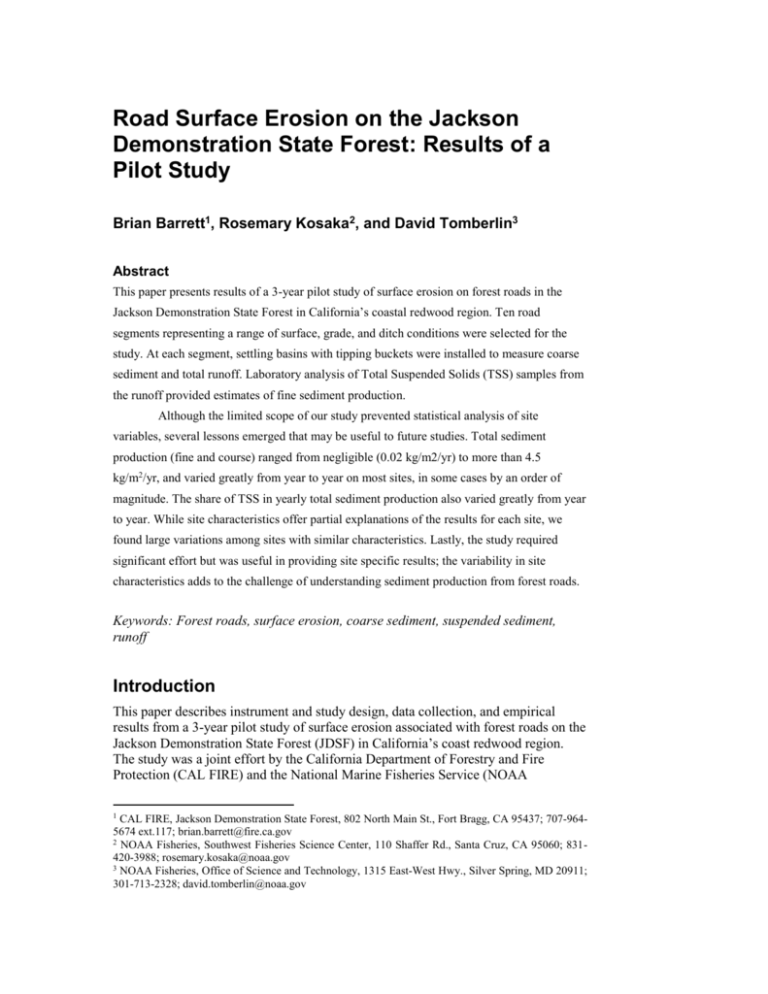
Road Surface Erosion on the Jackson Demonstration State Forest: Results of a Pilot Study Brian Barrett1, Rosemary Kosaka2, and David Tomberlin3 Abstract This paper presents results of a 3-year pilot study of surface erosion on forest roads in the Jackson Demonstration State Forest in California’s coastal redwood region. Ten road segments representing a range of surface, grade, and ditch conditions were selected for the study. At each segment, settling basins with tipping buckets were installed to measure coarse sediment and total runoff. Laboratory analysis of Total Suspended Solids (TSS) samples from the runoff provided estimates of fine sediment production. Although the limited scope of our study prevented statistical analysis of site variables, several lessons emerged that may be useful to future studies. Total sediment production (fine and course) ranged from negligible (0.02 kg/m2/yr) to more than 4.5 kg/m2/yr, and varied greatly from year to year on most sites, in some cases by an order of magnitude. The share of TSS in yearly total sediment production also varied greatly from year to year. While site characteristics offer partial explanations of the results for each site, we found large variations among sites with similar characteristics. Lastly, the study required significant effort but was useful in providing site specific results; the variability in site characteristics adds to the challenge of understanding sediment production from forest roads. Keywords: Forest roads, surface erosion, coarse sediment, suspended sediment, runoff Introduction This paper describes instrument and study design, data collection, and empirical results from a 3-year pilot study of surface erosion associated with forest roads on the Jackson Demonstration State Forest (JDSF) in California’s coast redwood region. The study was a joint effort by the California Department of Forestry and Fire Protection (CAL FIRE) and the National Marine Fisheries Service (NOAA 1 CAL FIRE, Jackson Demonstration State Forest, 802 North Main St., Fort Bragg, CA 95437; 707-9645674 ext.117; brian.barrett@fire.ca.gov 2 NOAA Fisheries, Southwest Fisheries Science Center, 110 Shaffer Rd., Santa Cruz, CA 95060; 831420-3988; rosemary.kosaka@noaa.gov 3 NOAA Fisheries, Office of Science and Technology, 1315 East-West Hwy., Silver Spring, MD 20911; 301-713-2328; david.tomberlin@noaa.gov GENERAL TECHNICAL REPORT PSW-GTR-19x Fisheries). Our goals were to assess the method and to collect data over a representative range of conditions. Increasing our understanding of road surface erosion will help land managers and resource agencies improve watershed management. Watershed processes are complex and our pilot study is not definitive. While our study is too limited to support strong conclusions, a broader-scale application of the methods described here could provide a basis for assessing the predictive power of erosion simulation models and help to inform priorities for restoration funding. METHODS Study area and site characteristics The ten road segments (sites) in this road surface erosion study are located on the JDSF in Mendocino County, California. The study area has a Mediterranean climate, with most of the precipitation (annual mean = 1.16 m) occurring as rainfall from November through April. The area is mountainous, with elevations ranging from sea level to 880 m (2,850 ft). Topography is generally steep and dissected as a result of rapid uplift rates. Underlying geologic materials are dominated by coastal belt Franciscan sandstone, and soils range from gravelly loam to fine-grained with a high clay content. Study sites were chosen to represent a range of surface, grade, and ditch conditions typical of forest roads in the redwood region. Site selection was also influenced by operational considerations such as placement on the hillslope, travel distances, and risk of vandalism. Individual sites varied in topography, cut-bank height, ditch vegetation, overhead canopy, and year of construction or maintenance. Road surface conditions were also variable. Some native surface roads contained a fraction of native rock, while rocked roads had variations in the condition of applied rock. The road segments were selected from the existing network of crowned roads with inside ditches and ditch relief culverts, representative of many roads on the JDSF and in the region, but different from roads that utilize outsloping and rolling dips. This road type provided reasonable hydrologic isolation without re-construction or the construction of new roads. Road maintenance consisting of grading to clear ditches of soil and debris, smoothing the road surface, and removing brush for vehicle clearance, was implemented under normal scheduling on the existing road network and not controlled for the study. An example of a study site can be seen in figure 1. Basic information on the sites is presented in table 1. Title of the document Figure 1 – Site 8, December HY07, showing rocked road surface following summer grading. Table 1 – Site characteristics for HY05 to HY06. Minor changes in catchment area during the study period are not reflected here but were captured in calculation of results. Road maintenance did not occur for sites 3, 4, 5, 9, and 10 during the study period. Site (road segment) 1 (1000-1) 2 (240-1a) 3 (90-1) 4 (210-2) 5 (210-1) 6 (240-1) 7 (600-4) 8 (620-4) 9 (640-7) 10 (640-1) Surface Winter traffic Native Light Ditch (percent vegetated) 10% Native Native Native Native Native Rocked Rocked Rocked Rocked None None None None None Light Light Light Light 0% 10% 10% 10% 0% 75% 30% 30% 20% Grade Area (m2) 6% 1031 4% 6% 6% 7% 9% 4% 7% 7% 4% 716 634 778 560 399 757 452 723 573 Road maintenance (grading) Prior to HY05, HY07 Prior to HY06 Prior to HY06 Prior to HY07 Prior to HY07 Surface flow on each road segment flowed to an inside ditch, from which a culvert directed it to devices that measured runoff and sediment production, as described below. Thus, the inside ditch was part of the road segment profile, although its relative contribution to sediment production is unknown. The catchment area for runoff on each site was measured from the base of the cut bank to the estimated crown of the road that served as a “water divide.” Sporadic surface flow was observed from cut banks at four sites and varied with storm intensity. Because the GENERAL TECHNICAL REPORT PSW-GTR-19x actual catchment area for each segment could not be known precisely and likely varied to some extent with rainfall intensity, we have explored the sensitivity of our results to potential measurement error. However, in this paper we report results based on the single catchment area value deemed most probable for each segment. Instrument design and calibration Our method of estimating runoff and sediment production was based on a design by Black and Luce (2007). Each site had a settling basin that captured coarse sediment generated on the road segment, a tipping bucket with event logger that enabled estimation of total runoff, and a splash device that collected a subsample of the runoff for analysis of suspended solids. A 5 ml subsample (circa 0.05 percent of tipping volume) was collected at each tip of the approximately 10 L bucket and flowed through a flexible tube into a closed 19 L (5 gal) bucket, which acted as a reservoir for composite post-storm sampling. An example can be seen in figure 2. Each tipping bucket was calibrated by providing flow at a known rate, using a flow meter, and recording the resulting duration between tips. Repeating this procedure with different flow rates enabled estimation of a calibration curve relating flow rate to duration between tips. Durations recorded by the data logger could then be used in conjunction with the calibration curves to estimate runoff on each segment, generating a hydrograph for each segment throughout the winter season. Figure 2 – Site 10 in operation with coarse sediment collection tank, tipping bucket, and suspended sediment sample bucket with tubing. Title of the document Data collection and analysis Runoff and suspended solids data were collected throughout the rainy season. Regular visits, sometimes several per week, to the study sites were necessary to download tipping times from the event loggers. When the 19 L buckets containing splash samples were nearing capacity, or when a sample had not been taken for several weeks, a mechanically agitated composite sample was collected from the buckets for analysis of suspended solids at a commercial laboratory using the EPA 160.2 protocol (1999). We measured total suspended solids (TSS) rather than suspended sediment concentration (SSC) due to budget considerations and the finding in Gray and others (2000) that these measures differ little when the proportion of coarse sediment is small. In our study, because the settling basin captured most of the coarse sediment before TSS samples were taken, we did not expect TSS and SSC to differ markedly. The coarse sediment captured by each settling basin was weighed at the end of the hydrologic year with a 2,000 kg (+/- 500 g) electronic dynamometer/crane scale. Each settling basin was topped off with water and the tank containing sediment and water was weighed and compared to the weight of the tank and water without sediment. These mass estimates were used to estimate the mass of dry sediment, as in Black and Luce (2007). Results Precipitation patterns and changes in site characteristics (largely due to road maintenance) are keys to interpreting our results. According to data from the U.S. Forest Service (USFS) Redwood Sciences Lab, precipitation at the South Fork Caspar Creek weir, located on the JDSF, totaled 1.69 m in HY06 (defined as 8/1/05 to 7/31/06), 0.86 m in HY07, and 1.00 m in HY08. Mean annual rainfall measured at the weir during 1963 to 2010 was 1.16 m (L. Keppler and J. Seehafer, USFS, personal communication, 6/15/11). Figure 3 shows total runoff (in kl/m2) at each study site. Note that runoff data from sites 1 and 10 were not collected in HY08 due to constraints on staff time for travel to remote locations. GENERAL TECHNICAL REPORT PSW-GTR-19x Figure 3 – Total runoff (kl/m2) for each site, HY06 to HY08. Data are normalized by area Runoff was not collected for sites 1 and 10 in HY08. Figure 4 shows annual sediment production per square meter on each road segment. Total sediment production ranged from negligible (0.02 kg/m2/yr) to more than 4.5 kg/m2/yr, and varied greatly from year to year on most sites, in some cases by an order of magnitude. While the highest-producing road segments were native surface segments, one native surface segment (site 4) produced less sediment on average than three of the four rocked surface segments. Figure 4 – Fine and coarse sediment production (kg/m2) for each site, HY06 to HY08. Data are normalized by area. Sites 1 through 6 are native surface roads while sites 7 through 10 are rocked surface roads. Fine sediment was not collected for sites 1 and 10 for HY08. Dots indicate sites where grading occurred in one or two previous hydrologic years (see table 1). Assuming a road surface bulk density of 1,600 kg/m3 (Coe 2006), the sediment production rates given in figure 4 correspond to surface depth loss rates of Title of the document 0.03 mm/yr to 2.85 mm/yr. The share of suspended solids in total sediment production generally ranged from 30 percent to 90 percent, with a mass-weighted mean of 52 percent. Discussion Our results indicate that both total sediment production rates and the share of suspended sediment in total sediment differ greatly among sites and over time. Site 1 alone produced 45 percent of the total sediment produced on all the sites during the study period, despite the fact that fine sediment production data was not collected on this site in the final year. Site 4, in contrast, produced less than 1 percent of the total. Some of this variation can be attributed to known site characteristics, for example, site 1 has the greatest area, receives some light winter traffic, and was the only one graded prior to HY05. All four of the highest-producing segments in our study are native surface segments, but two native surface segments (sites 4 and 5) produced sediment at rates similar to the rocked segments. As shown in figure 4, the four highest annual sediment production totals were on road segments that had been recently graded to clear ditches of debris and smooth the road surface. This complicates the relationship between rocked and native surface roads because grading may have contributed more to sediment production than surface type. In the case of site 1, the first grading was prior to HY05 but the effects of grading appeared to be evident in HY06. Sediment production at sites without grading declined through the 3-year study period, except site 2 which increased slightly. Other factors, such as geology, topography, and ditch function, no doubt played a role as well, but we did not have sufficient data to support a statistical analysis of factors influencing variability in sediment production. Further, more data and analysis of erosion rates, rainfall intensities, and grading histories would be necessary to assess a cause and effect relationship between erosion and grading. For example, a simple conclusion that grading alone causes subsequent erosion does not consider the possibility that some road segments may have inherent design flaws leading to more frequent grading. Two points are particularly worth noting in interpreting our results. First, HY06 was a very wet year (147% of average), and accounted for an estimated 70 percent of total sediment production on our study sites over the three-year period. Second, we have not attempted to control for the influence of traffic, since all our road segments are either closed in winter or are believed to be used by 10 or fewer light-duty vehicles (pickups and sedans) per week. Our results are generally comparable to erosion measurements made in other forested areas of California. An application of the Water Erosion Prediction Project (WEPP) simulation model (Ish and Tomberlin 2007) generated a mean long-term surface erosion rate estimate of 4.14 kg/m2 on native surface roads in our study area, which is similar to the higher sediment production rates shown in figure 4. In studies from the interior portions of California, Coe (2006) reported a 16-fold difference in median sediment production rates between rocked and native road segments in the central Sierra Nevada, while Korte and MacDonald (2007) found that native and mixed surface roads (0.7 kg/m2/yr) produced approximately three times the sediment as gravel surfaced roads (0.23 kg/m2/yr) in the southern Sierra Nevada. GENERAL TECHNICAL REPORT PSW-GTR-19x The results presented here are not definitive, as they represent data from only three years, and we have not yet fully explored the sensitivity of the results to uncertainties about sediment concentrations, catchment areas, and equipment function. A particularly important example of the latter was marked differences in the calibration coefficients for some tanks before and after the rainy season. Because we cannot know the rate at which the calibration coefficients changed during the season, the results reported here are based on a simple linear interpolation over time between the pre- and post-season calibration coefficients. Examining the sensitivity of our results to other possible patterns of change in the calibration coefficients—for example, such that the initial coefficients were operative until the last day of the season, or that the final coefficients were operative after the first day of the season— showed that the results were not very sensitive to this source of uncertainty. Additionally, several known technical problems add to the uncertainty in our results. Because HY06 was a heavy rain year, 47 of 338 total data downloads (14 percent) indicated that the data logger had filled, resulting in some lost data. There was also some minor equipment damage due to site visitors, for example, on two occasions the tubing directing runoff subsamples to a collection reservoirs were removed. On site 7, an old buried culvert was found to be directing a significant amount of water from the study segment under the road and away from our instruments, which may explain the observed increase in runoff during the later, drier years of the study. We changed the filter size for TSS analysis from 1.5 to 1.0 microns after the first year, which increased by an unknown amount the estimated fine sediment production levels in HY07 and HY08 relative to what would have been captured with a 1.5 micron filter. There are important questions related to road surface runoff and erosion that are beyond the scope of our study. We have not attempted to develop a statistical analysis of the factors contributing to road sediment production nor to assess delivery of sediment to the stream network. We did not do a comprehensive assessment of the share of organic material in our TSS samples, though in tests on a small (n=12) number of runoff samples the share of organics in TSS was found to be as high as 18 percent. This suggests that on some sites distinguishing organic from inorganic sediment would be important to estimating mineral sediment production. The goals of this study were more limited: 1) to examine the feasibility of a particular approach to estimating road surface erosion in the redwood region, and 2) to generate estimates of sediment production on an existing network of crowned roads with inside ditches. The results presented here suggest that the method generates useful information, and clearly demonstrate that the application of generic rules of thumb to estimate sediment production at a given site may result in gross errors. The information, however, comes at a significant cost: instrumentation at each site cost approximately $1,800; project initiation and data collection during the first year required approximately one staff person per year; and maintenance, data collection, and analysis in subsequent years required approximately half of one staff person per year. However, it may be possible to lower costs and improve measurement accuracy by reducing the tank size on sites anticipated to have lower sediment production. Title of the document Conclusion This pilot study of forest road surface erosion demonstrated remarkable variability among sites and years in the production of both fine and coarse sediment. Although the methodology was successful in providing site specific data on sediment production, the variability of site characteristics and small number of segments limits the ability to make conclusions. The results showed rocked road segments produced less sediment than most native surface segments, though two native surface segments produced amounts comparable to the rocked segments. The native surface roads with the highest sediment production had also been graded so it is unknown if the high production was the result of the surface type, grading, site characteristics, or a combination of factors. The share of fine sediment in total sediment was also highly variable, but generally more than 30 percent and in some cases almost 90 percent. These results, taken cumulatively, offer a cautionary tale about the perils of estimating sediment production based on rules of thumb. The chief advantage of the method applied here is that it can provide useful, site-specific estimates of both fine and coarse sediment production. The disadvantages are that the method is expensive and labor-intensive, requiring significant staff time for data collection, analysis and equipment maintenance. Acknowledgements: This project has been funded by the National Marine Fisheries Service (NOAA Fisheries) and the California Department of Forestry and Fire Protection (CAL FIRE). We thank C. Luce (USFS) for advice on instrument and study design. We also thank B. Baxter (CAL FIRE), P. Cafferata (CAL FIRE), J. Griffen (CAL FIRE), L. Keppeler (USFS), J. Lewis (USFS), and J. Seehafer (USFS) for helpful discussions and suggestions; R. Collins (CAL FIRE), B. Salee (CAL FIRE), J. Bawcom (CAL FIRE), R. Hundt (CAL FIRE), B. Perez (CAL FIRE), M. Lombardi (CAL FIRE), and A. D’Albert (CAL FIRE) for field work; S. Weir (CAL FIRE) and the Department of Corrections inmates at Parlin Fork Conservation Camp for manufacturing the tanks; the CAL FIRE Fire Crews from Chamberlain Creek Conservation Camp for manually weighing the coarse sediment; A. Mamula (NOAA Fisheries), C. Thomson (NOAA Fisheries), and two anonymous reviewers for their comments and suggestions; and M. Jameson (CAL FIRE) and C. Thomson (NOAA Fisheries) for material support and for providing us time to work on this project. GENERAL TECHNICAL REPORT PSW-GTR-19x Literature cited Black, T.A.; Luce, C.H. 2007 (8/15/07 version). Measuring water and sediment discharge from a bordered road plot using a settling basin and tipping bucket. USDA Forest Service Rocky Mountain Research Station, Boise, ID. 37 p. Available at: http://www.fs.fed.us/GRAIP/downloads/NewRoadPlotv3.pdf Coe, D.B.R. 2006. Sediment production and delivery from forest roads in the Sierra Nevada, California. Fort Collins, CO: Colorado State University; 110 p. M.S. thesis. Available at: http://www.fire.ca.gov/cdfbofdb/pdfs/DrewCoe_FinalThesis.pdf Gray, J.R.; Glysson, G.D.; Turcios, L.M.; Schwartz, G.E. 2000. Comparability of suspended-sediment concentration and total suspended solids data. WaterResources Investigations Report 00-4191. Reston, VA: US Dept. of Interior, U.S. Geological Service. Available at: http://water.usgs.gov/osw/pubs/WRIR00-4191.pdf Ish, T.; Tomberlin, D. 2007. Simulation of surface erosion on a logging road in the Jackson Demonstration State Forest. In: Proceedings of the Redwood Science Symposium, Standiford, R., and others, eds. USDA US Forest Service Gen. Tech. Rep. PSW-GTR-194; 457-463. Available at: http://swfsc.noaa.gov/publications/FED/00697.pdf Korte, A.; MacDonald, L.H. 2007. Preliminary summary: sediment production and delivery in the southern Sierra Nevada. Unpublished draft (3/1/07 version). Fort Collins, CO: Watershed Science Program, Colorado State University; 11 p. U.S. EPA. 1999 (revised 11/16/99). Total Suspended Solids (TSS), EPA Method 106.2 (Gravimetric, Dried at 103-105 C). Data Quality Indicator Tables. Pacific Southwest, Region 9. Available at: http://www.epa.gov/region9/qa/datatables.html
